Vertical Ozone Gradients above Forests. Comparison of Different Calculation Options with Direct Ozone Measurements above a Mature Forest and Consequences for Ozone Risk Assessment
Abstract
:1. Introduction
2. Materials and Methods
2.1. Estimation of Ozone Concentrations at the Top of the Forest Canopy from Measurements Taken above a Nearby Short Grassland
2.2. Experimental Data and Site Description
2.3. Ozone Concentration Measurements
2.4. Ozone Flux Measurements and POD Calculation
2.5. Simulations and Comparisons (Tested Calculation Options)
- By using a constant L value representing the different theoretical stability classes of the testing area: 1/L approaching 0 for neutral conditions, 1/L = −0.01 for unstable conditions, 1/L = −0.1 for very unstable conditions, 1/L = +0.01 for stable conditions.
- By using the hourly value of the M-O length L which was obtained:
- (a)
- directly from the eddy covariance measurements;
- (b)
- Bestimation from standard meteorological measurements following the procedure illustrated in Appendix A.
- By using the seasonal average and the median values of the in situ measured M-O length L.
- By using only Equation (1) to calculate the O3 concentration above the forest top-canopy (by setting zup = 30 m), i.e., by assuming that the O3 gradient above the forest was the same as the one calculated above the grassland, thus neglecting the effect of forest geometry and physiology on the O3 deposition flux.
- By using the noon concentration gradients tabulated in the UN/ECE Mapping Manual [16] suggested for case studies without available meteorological measurements to estimate the value of the M-O length L.
- By directly using the O3 concentration measured at 2 m above the grassland as a surrogate of the O3 concentration above the forest top-canopy (no gradients calculation), i.e., by assuming a vertical isoconcentration profile.
3. Results
4. Discussion
5. Conclusions
Acknowledgments
Author Contributions
Conflicts of Interest
Appendix A
Estimation of the Obukhov Length (L)
Estimation of the Net Radiation (Rn)
Estimation of the Sensible Heat Flux (H)
| Values for the Parameter α | ||
|---|---|---|
| From | To | Description |
| 0 | 0.2 | Arid desert without rainfalls for months |
| 0.2 | 0.4 | Rural arid area |
| 0.4 | 0.6 | Agricultural fields in periods with no rainfalls for long periods |
| 0.5 | 1 | Urban environment |
| 0.8 | 1.2 | Agricultural fields or forests with sufficient water availability |
| 1.2 | 1.4 | Big lake or ocean, far at least 10 km from the shore |
Estimation of the Friction Velocity (u*)
References
- Paoletti, E.; de Marco, A.; Beddows, D.C.; Harrison, R.M.; Manning, W.J. Ozone levels in European and USA cities are increasing more than at rural sites, while peak values are decreasing. Environ. Pollut. 2014, 192, 295–299. [Google Scholar] [CrossRef] [PubMed]
- Büker, P.; Feng, Z.; Uddling, J.; Briolat, A.; Alonso, R.; Braun, S.; Elvira, S.; Gerosa, G.; Karlsson, P.E.; Le Thiec, D.; et al. New flux based dose–response relationships for ozone for European forest tree species. Environ. Pollut. 2015, 206, 163–174. [Google Scholar] [CrossRef] [PubMed]
- Marzuoli, R.; Monga, R.; Finco, A.; Gerosa, G. Biomass and physiological responses of Quercus robur (L.) young trees during 2 years of treatments with different levels of ozone and nitrogen wet deposition. Trees 2016, 30, 1995–2010. [Google Scholar] [CrossRef]
- Sicard, P.; de Marco, A.; Dalstein-Richier, L.; Tagliaferro, F.; Renou, C.; Paoletti, E. An epidemiological assessment of stomatal ozone flux-based critical levels for visible ozone injury in Southern European forests. Sci. Total Environ. 2016, 541, 729–741. [Google Scholar] [CrossRef] [PubMed]
- Ochoa-Hueso, R.; Munzi, S.; Alonso, R.; Arroniz-Crespo, M.; Avila, A.; Bermejo, V.; Bobbink, R.; Branquinho, C.; Concostrina-Zubiri, L.; Cruz, C.; et al. Ecological impacts of atmospheric pollution and interactions with climate change in terrestrial ecosystems of the Mediterranean Basin: Current research and future directions. Environ. Pollut. 2017, 227, 194–206. [Google Scholar] [CrossRef] [PubMed]
- Makar, P.A.; Staebler, R.M.; Akingunola, A.; Zhang, J.; McLinden, C.; Kharol, S.K.; Pabla, B.; Cheung, P.; Zheng, Q. The effects of forest canopy shading and turbulence on boundary layer ozone. Nat. Commun. 2017, 8. [Google Scholar] [CrossRef] [PubMed]
- Wesely, M.L.; Hicks, B.B. Some factors that affect the deposition rates of sulfur dioxide and similar gases on vegetation. J. Air Pollut. Control Assoc. 1977, 27, 1110–1116. [Google Scholar] [CrossRef]
- Wolfe, G.M.; Thornton, J.A.; McKay, M.; Goldstein, A.H. Forest-atmosphere exchange of ozone: Sensitivity to very reactive biogenic VOC emissions and implications for in-canopy photochemistry. Atmos. Chem. Phys. 2011, 11, 7875–7891. [Google Scholar] [CrossRef] [Green Version]
- De Arellano, J.V.G.; Duynkerke, P.G. Influence of chemistry on the flux-gradient relationships for the NO-O3-NO2 system. Bound.-Layer Meteorol. 1992, 61, 375–387. [Google Scholar] [CrossRef]
- Tuovinen, J.P.; Simpson, D. An aerodynamic correction for the European ozone risk assessment methodology. Atmos. Environ. 2008, 42, 8371–8381. [Google Scholar]
- Grünhage, L.; Haenel, H.D.; Jäger, H.J. The exchange of ozone between vegetation and atmosphere: Micrometeorological measurement techniques and models. Environ. Pollut. 2000, 109, 373–392. [Google Scholar] [CrossRef]
- Finnigan, J. Turbulence in plant canopies. Annu. Rev. Fluid Mech. 2000, 32, 519–571. [Google Scholar] [CrossRef]
- Katul, G.; Cava, D.; Poggi, D.; Albertson, J.; Mahrt, L. Stationarity, Homogeneity, and Ergodicity in Canopy Turbulence. In Handbook of Micrometeorology; Lee, X., Massman, W., Law, B., Eds.; Springer: Dordrecht, The Netherlands, 2004; volume 29. [Google Scholar]
- Tuovinen, J.P.; Emberson, L.; Simpson, D. Modelling ozone fluxes to forests for risk assessment: Status and prospects. Ann. For. Sci. 2009, 66, 1–14. [Google Scholar] [CrossRef]
- Emberson, L.D.; Ashmore, M.R.; Cambridge, H.M.; Simpson, D.; Tuovinen, J.P. Modelling stomatal ozone flux across Europe. Environ. Pollut. 2000, 109, 403–413. [Google Scholar] [CrossRef]
- CLRTAP-UNECE Convention on Long-Range Transboundary Air Pollution. Mapping Critical Levels for Vegetation. Chapter III of Manual on Methodologies and Criteria for Modelling and Mapping Critical Loads and Levels and Air Pollution Effects, Risks and Trends. 2015. Available online: http://icpvegetation.ceh.ac.uk/publications/documents/Ch3-MapMan-2016-05-03_vf.pdf (accessed on 15 October 2016).
- Garratt, J.R. The atmospheric boundary layer. Earth-Sci. Rev. 1994, 37, 89–134. [Google Scholar] [CrossRef]
- Gerosa, G.; Ballarin-Denti, A. Regional scale risk assessment of ozone and forests. Dev. Environ. Sci. 2003, 3, 119–139. [Google Scholar]
- Simpson, D.; Benedictow, A.; Berge, H.; Bergström, R.; Emberson, L.D.; Fagerli, H.; Flechard, C.R.; Hayman, G.D.; Gauss, M.; Jonson, J.E.; et al. The EMEP MSC-W chemical transport model–technical description. Atmos. Chem. Phys. 2012, 12, 7825–7865. [Google Scholar] [CrossRef] [Green Version]
- Van Pul, W.A.J.; Jacobs, A.F.G. The conductance of a maize crop and the underlying soil to ozone under various environmental conditions. Bound.-Layer Meteorol. 1994, 69, 83–99. [Google Scholar] [CrossRef]
- Monin, A.S.; Obukhov, A.M. Osnovnye zakonomernosti turbulentnogo peremesivanija v prizemnom sloe atmosfery (Basic laws of turbulent mixing in the atmosphere near the ground). Trudy geofiz. Inst. AN SSSR 1954, 24, 163–187. [Google Scholar]
- Gerosa, G.; Finco, A.; Marzuoli, R.; Tuovinen, J.P. Evaluation of the uncertainty in the ozone flux effect modelling: From the experiments to the dose–response relationships. Atmos. Environ. 2012, 54, 44–52. [Google Scholar] [CrossRef]
- Jarvis, P.G. The interpretation of the variations in leaf water potential and stomatal conductance found in canopies in the field. Philos. Trans. R. Soc. Lond. Ser. B: Biol. Sci. 1976, 273, 593–610. [Google Scholar] [CrossRef]
- Büker, P.; Morrissey, T.; Briolat, A.; Falk, R.; Simpson, D.; Tuovinen, J.P.; Alonso, R.; Barth, S.; Baumgarten, M.; Grulke, N.; et al. DO3SE modelling of soil moisture to determine ozone flux to European forest trees. Atmos. Chem. Phys. Discuss. 2011, 11, 33583–33650. [Google Scholar] [CrossRef] [Green Version]
- Longo, L. Rapporti Scientifici 1. Centro Nazionale Biodiversità Forestale Verona-Bosco della Fontana. In Dinamica di una foresta della Pianura Padana. Bosco della Fontana. Seconda edizione con Linee di gestione forestale; Mason, F., Ed.; Gianluigi Arcari Editore: Mantua, Italy, 2006; pp. 16–17. [Google Scholar]
- Güsten, H.; Heinrich, G.; Schmidt, R.W.H.; Schurath, U. A novel ozone sensor for direct eddy flux measurements. J. Atmos. Chem. 1992, 14, 73–84. [Google Scholar]
- Güsten, H.; Heinrich, G. On-line measurements of ozone surface fluxes: Part I. Methodology and instrumentation. Atmos. Environ. 1996, 6, 897–909. [Google Scholar] [CrossRef]
- Vickers, D.; Mahrt, L. Quality Control and Flux Sampling Problems for Tower and Aircraft Data. J. Atmos. Ocean. Technol. 1997, 14, 512–526. [Google Scholar] [CrossRef]
- Lee, X.; Massman, W.; Law, B. Handbook of Micrometeorology: A Guide for Surface Flux Measurements and Analysis; Springer: Dordrecht, The Netherlands, 2004. [Google Scholar]
- Aubinet, M.; Vesala, T.; Papale, D. Eddy Covariance: A Practical Guide to Measurement and Data Analysis; Springer: Dordrecht, The Netherlands, 2012; p. 438. [Google Scholar]
- Rummel, U.; Ammann, C.; Kirkman, G.A.; Moura, M.A.L.; Foken, T.; Andreae, M.O.; Meixner, F.X. Seasonal variation of ozone deposition to a tropical rain forest in southwest Amazonia. Atmos. Chem. Phys. 2007, 7, 5415–5435. [Google Scholar] [CrossRef]
- Muller, J.B.A.; Percival, C.J.; Gallagher, M.W.; Fowler, D.; Coyle, M.; Nemitz, E. Sources of uncertainty in eddy covariance ozone flux measurements made by dry chemiluminescence fast response analysers. Atmos. Meas. Tech. 2010, 3, 163–176. [Google Scholar] [CrossRef]
- Webb, E.K.; Pearman, G.I.; Leuning, R. Correction of flux measurements for density effects due to heat and water vapour transfer. Q. J. R. Meteorol. Soc. 1980, 106, 85–100. [Google Scholar] [CrossRef]
- Foken, T.; Wichura, B. Tools for quality assessment of surface-based flux measurements. Agric. For. Meteorol. 1996, 78, 83–105. [Google Scholar] [CrossRef]
- Gerosa, G.; Vitale, M.; Finco, A.; Manes, F.; Ballarin-Denti, A.; Cieslik, S. Ozone uptake by an evergreen Mediterranean forest (Quercus ilex) in Italy. Part I: Micrometeorological flux measurements and flux partitioning. Atmos. Environ. 2005, 39, 3255–3266. [Google Scholar] [CrossRef]
- Gerosa, G.; Cieslik, S.; Ballarin-Denti, A. Micrometeorological determination of time-integrated stomatal ozone fluxes over wheat: A case study in Northern Italy. Atmos. Environ. 2003, 37, 777–788. [Google Scholar] [CrossRef]
- Holtslag, A.A.; van Ulden, A.P. A simple scheme for daytime estimates of the surface fluxes from routine weather data. J. Appl. Meteorol. Climatol. 1983, 22, 517–529. [Google Scholar] [CrossRef]
- NOAA, US Department of Commerce: National Oceanic and Atmospheric Administration. Solar Calculation Details. Available online: http://www.esrl.noaa.gov/gmd/grad/solcalc/calcdetails.html (accessed on 15 October 2016).
- Beljaars, A.C.M.; Holtslag, A.A. A software library for the calculation of surface fluxes over land and sea. Environ. Softw. 1989, 5, 60–68. [Google Scholar] [CrossRef]
- Beljaars, A.C.M.; Holtslag, A.A. Flux parametrization over land surfaces for atmospheric models. J. Appl. Meteorol. 1991, 30, 327–341. [Google Scholar] [CrossRef]
- Hanna, S.R.; Chang, J.C. Boundary layer parametrizations for applied dispersion modeling over urban areas. Bound.-Layer Meteorol. 1992, 58, 229–259. [Google Scholar] [CrossRef]
- Doll, D.; Ching, J.K.S.; Kaneshire, J. Parametrization of subsurfaces heating for soil and concrete using new radiation data. Bound.-Layer Meteorol. 1985, 32, 351–372. [Google Scholar] [CrossRef]
- Bassin, S.; Calanca, P.; Weidinger, T.; Gerosa, G.; Fuhrer, J. Modeling seasonal ozone fluxes to grassland and wheat: Model improvement, testing and application. Atmos. Environ. 2003, 38, 2349–2359. [Google Scholar] [CrossRef]
- WMO (World Meteorological Organization). Guide to Meteorological Instruments and Methods of Observation, 7th Edition ed. 2008. Available online: https://www.wmo.int/pages/prog/gcos/documents/gruanmanuals/CIMO/CIMO_Guide-7th_Edition-2008.pdf (accessed on 15 October 2016).

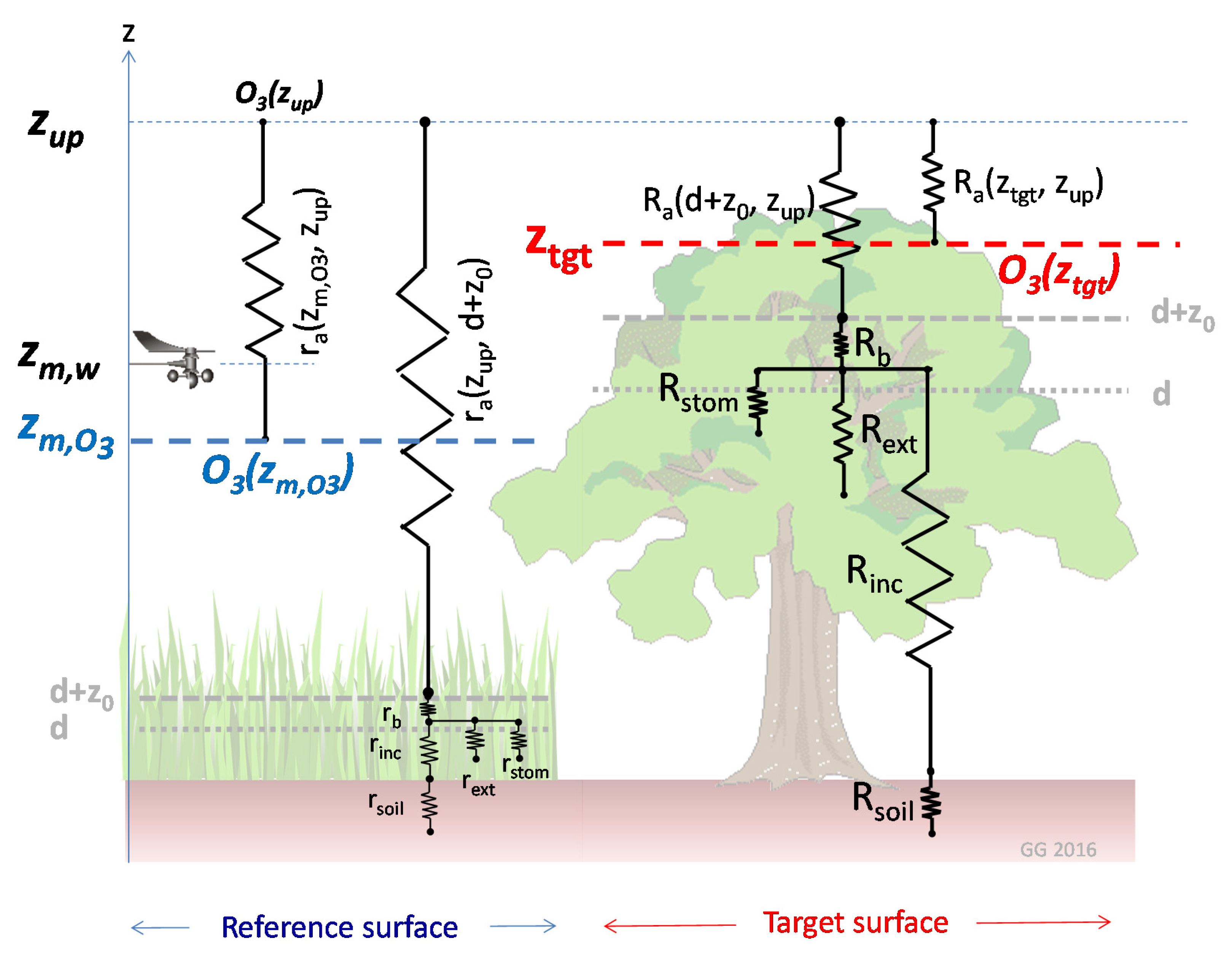
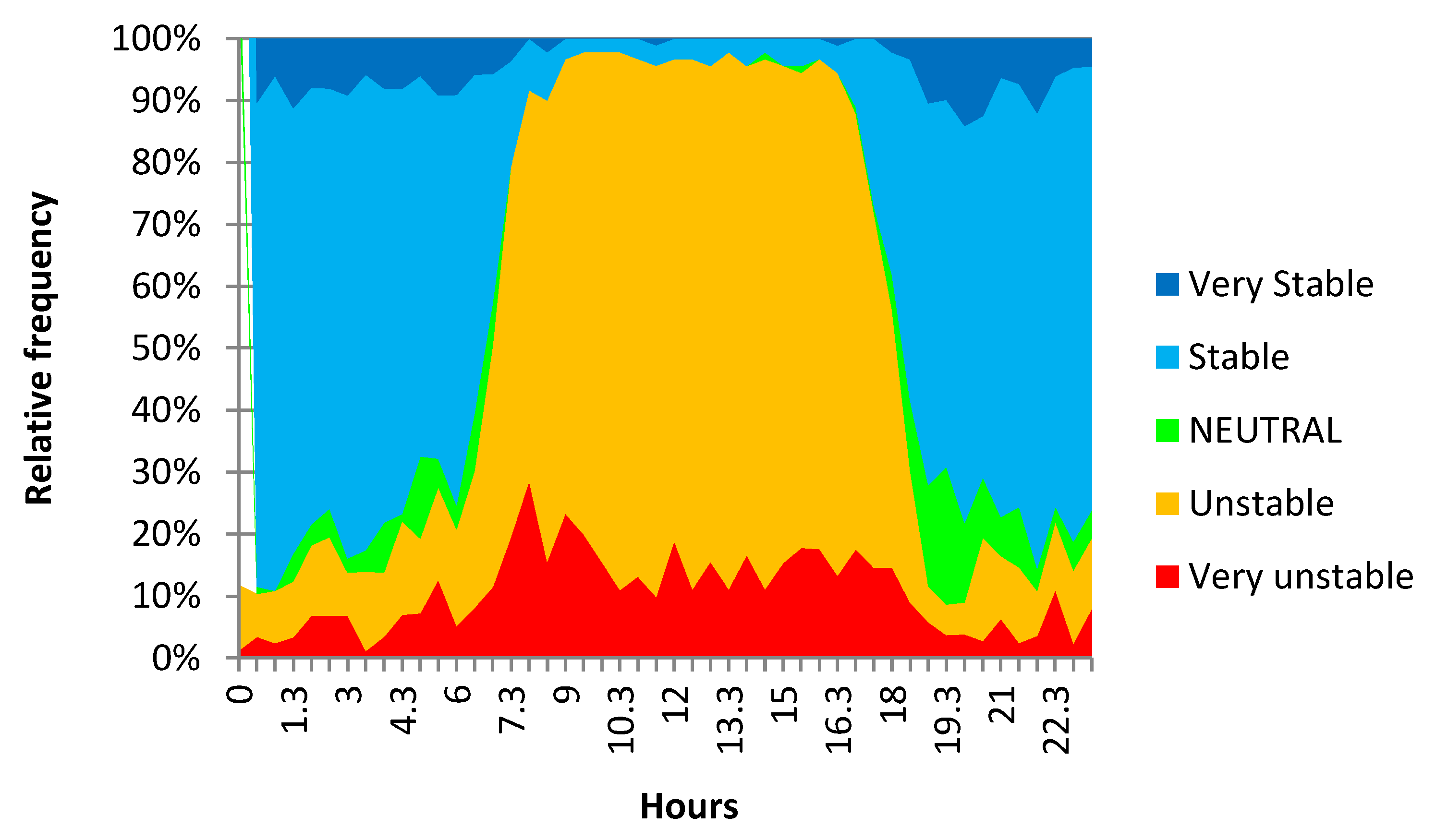
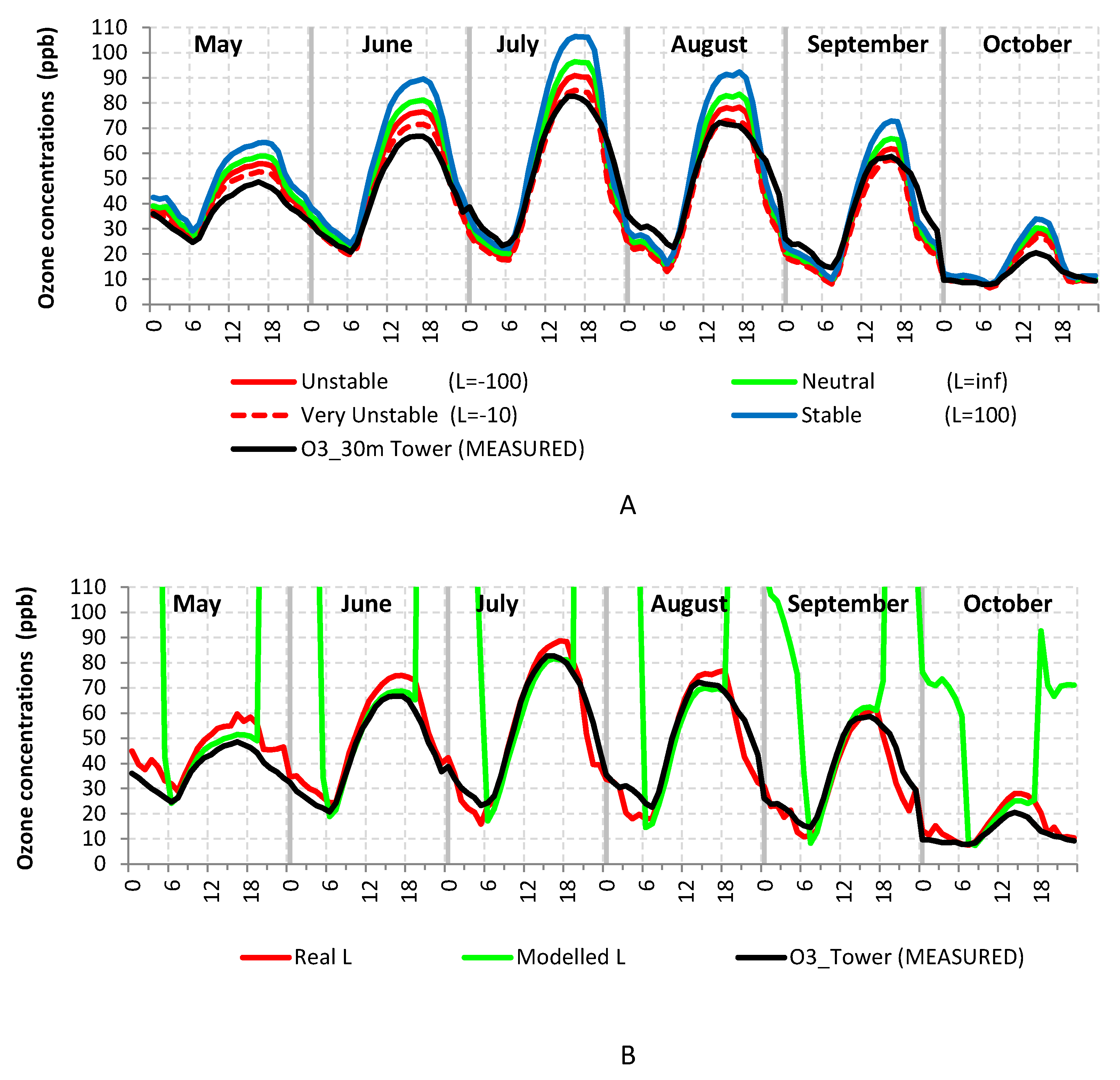
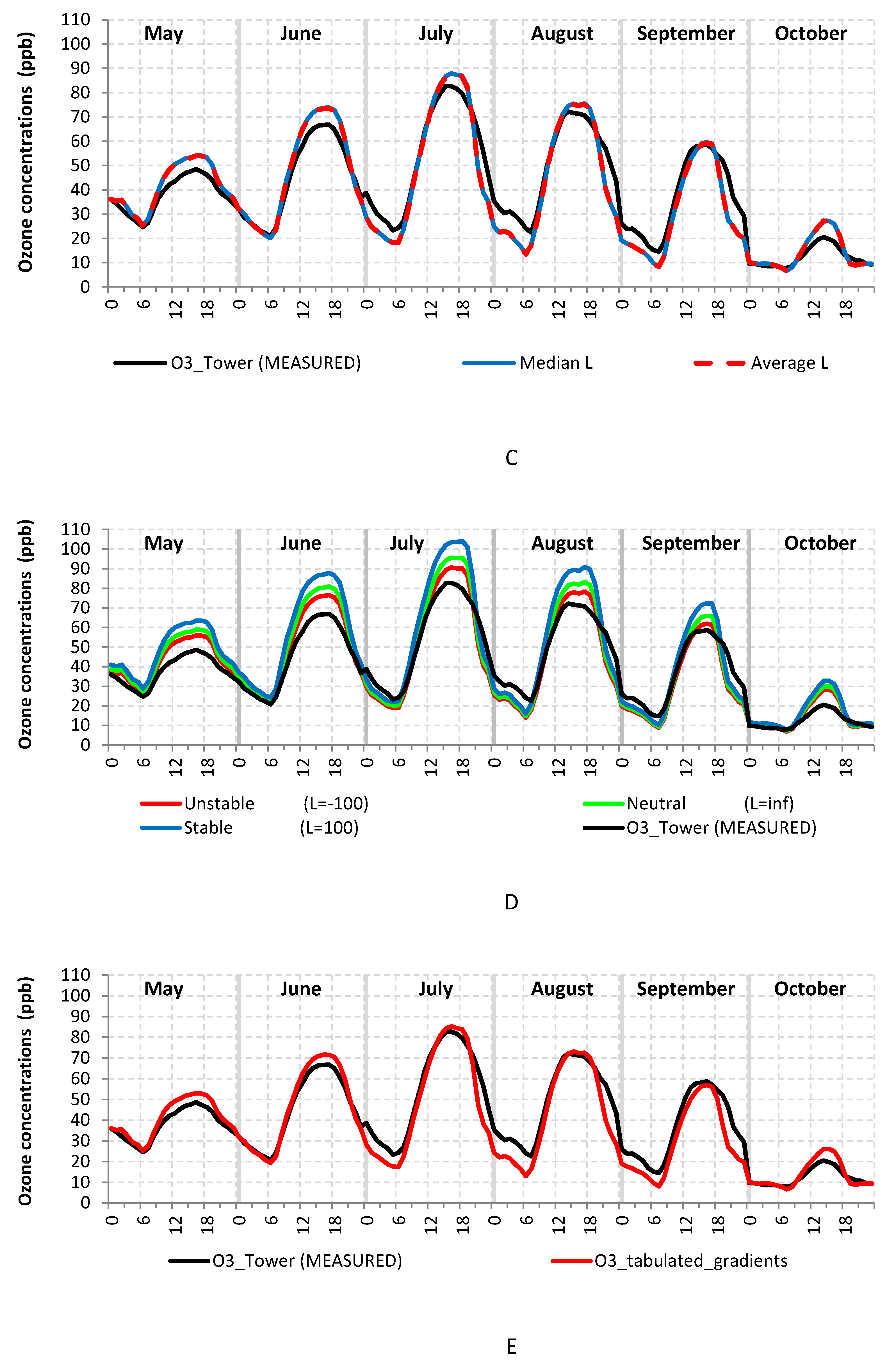
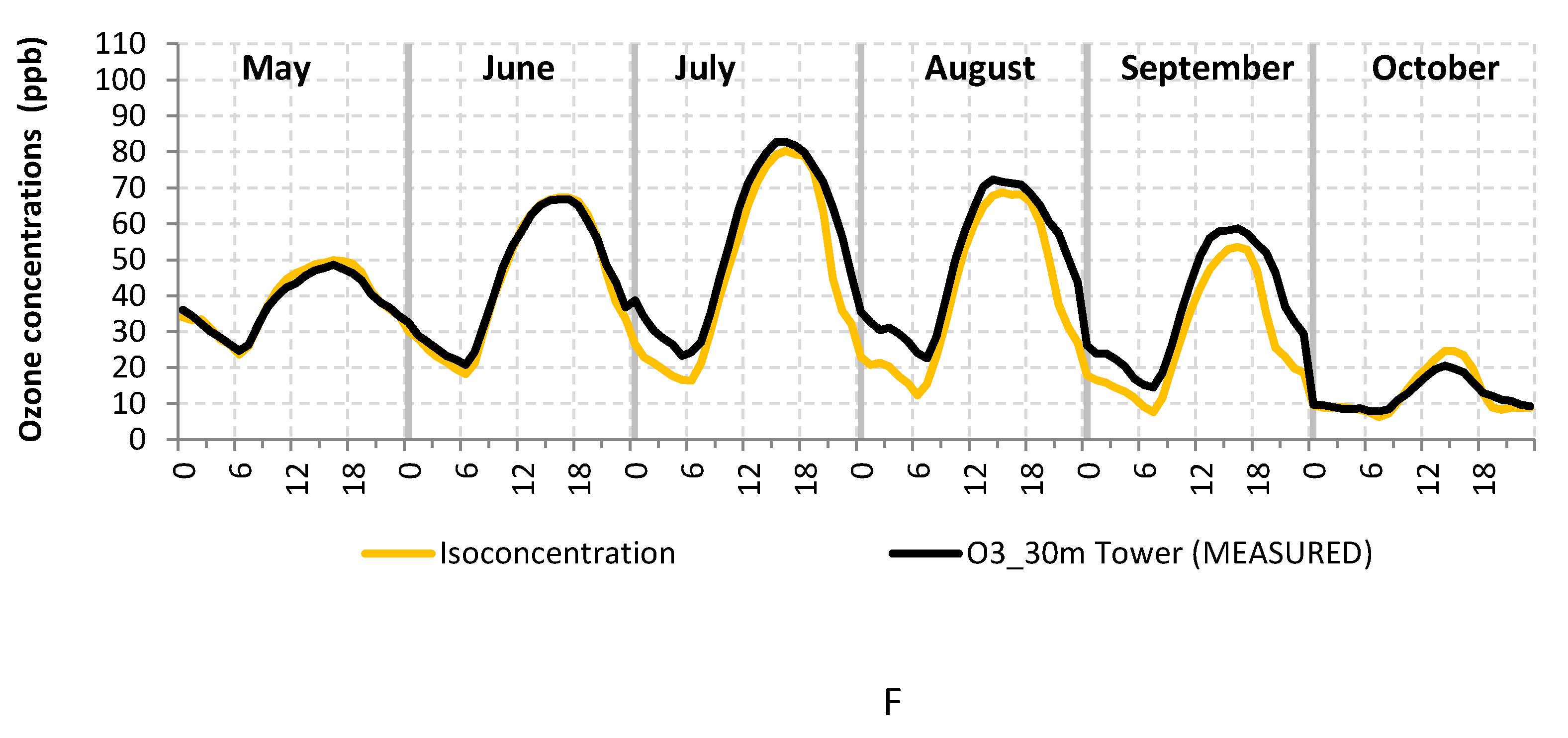
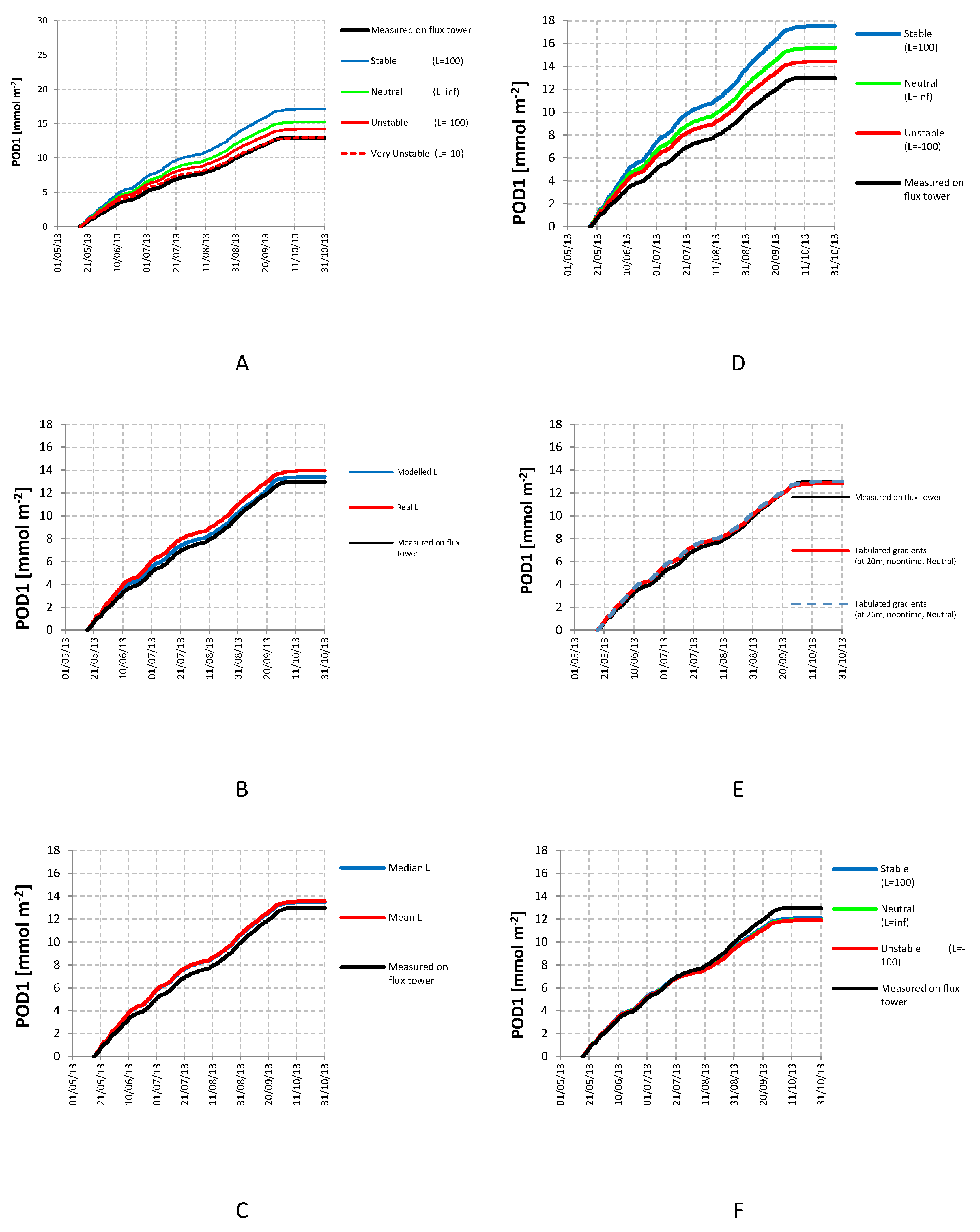
| Geometry | Grassland (Reference surface) | Forest (Target surface) | ||
|---|---|---|---|---|
| Canopy height | href | 0.05 m | htgt | 26 m |
| Displacement height | dref | 0.035 m | dtgt | 18.2 m |
| Roughness length | z0,ref | 0.005 m | z0,tgt | 2.6 m |
| Leaf Area Index | LAI | 3.5 | LAI | 3.5 |
| Surface Area Index | SAI | 3.5 | SAI | 4.5 |
| [O3] measuring height | Zm,O3 | 2 m | ||
| Wind speed measuring height | Zm,w | 2 m | ||
| Target height for [O3] calc. | ztgt | 24 m | ||
| Decoupling height | zup | 50 m | ||
| Constant Resistances | ||||
| Cuticular resistance to O3 dep. | rext | 2500 s/m | Rext | 2500 s/m |
| Soil resistance to O3 dep. | rsoil | 200 s/m | Rsoil | 200 s/m |
| Stomatal Conductance (gs) | ||||
| Maximum gs to H2O | gmax,H20 | 270 mmol m−2 s−1 | gmax,H20 | 230 mmol m−2 s−1 |
| Fmin | fmin | 0.01 | fmin | 0.06 |
| fPAR | alight | 0.009 | alight | 0.003 |
| fT | Tmin | 12 °C | Tmin | 0 °C |
| Topt | 26 °C | Topt | 20 °C | |
| Tmax | 40 °C | Tmax | 35 °C | |
| b | 1 | b | 0.75 | |
| fVPD | VPDmax | 1.3 KPa | VPDmax | 1.0 KPa |
| VPDmin | 3.0 KPa | VPDmin | 3.25 KPa | |
| fSWP | SWPmin | −1.5 MPa | SWPmin | −1.2 MPa |
| SWPmax | −0.49 MPa | SWPmax | −0.5 MPa | |
| fPHEN | SGS | 1 DOY | SGS | 105 DOY |
| fphen_1 | 0 days | fphen_1 | 20 days | |
| fphen_4 | 0 days | fphen_4 | 30 days | |
| fphen_a | 1 | fphen_a | 0 | |
| fphen_e | 1 | fphen_e | 0 | |
| EGS | 365 DOY | EGS | 297 DOY | |
| Soil Water | ||||
| Soil type | Clay-loam | Clay-loam | ||
| Water content at field capacity | SWCfc | 0.37 m3/m3 | SWCfc | 0.37 m3/m3 |
| Water content at wilting point | SWCwp | 0.1676 m3/m3 | SWCwp | 0.1676 m3/m3 |
| Ψe | −0.00588 MPa | Ψe | −0.00588 MPa | |
| bsoil | 7 | bsoil | 7 | |
| Root depth | rdepth | 0.80 m | rdepth | 1.00 m |
| Calculation options | Max difference with the O3 measured | Median difference with the O3 measured | ||
|---|---|---|---|---|
| 1—Theoretical stability | Stable | (L = 100 m) | 33% | 26% |
| Neutral | (L→∞ m) | 20% | 15% | |
| Unstable | (L = −100 m) | 1% | 9% | |
| Very Unstable | (L = −10 m) | 10% | 2% | |
| 2—Actual stability(*) | Real stability | (measured L) | 12% | 7% |
| Modelled stability | (estimated L) | 7% | 0% | |
| 3—Aver. actual stability | Mean stability | (L = 28.2 m) | 12% | 5% |
| Median stability | (L = 32.4 m) | 12% | 5% | |
| 4—Gradients on ref. veg. | Stable | (L = 100 m) | 34% | 16% |
| Neutral | (L→∞ m) | 22% | 10% | |
| Unstable | (L = −100 m) | 18% | 6% | |
| 5—Tab. gradients at 26 m | 9% | 2% | ||
| 6—Isoconcentration | Stable | (L = 100 m) | −11% | −4% |
| Neutral | (L→∞ m) | −11% | −4% | |
| Unstable | (L = −100 m) | −11% | −4% |
| Calculation options | Diff. with the measured top-canopy POD1 | ||
|---|---|---|---|
| 1—Theoretical stability | Stable | (L = 100 m) | +32% |
| Neutral | (L→∞ m) | +18% | |
| Unstable | (L = −100 m) | +9% | |
| Very Unstable | (L = −10 m) | 0% | |
| 2—Actual stability | Real stability | (measured L) | +8% |
| Modelled stability | (estimated L) | +3% | |
| 3—Aver. actual stability | Mean stability | (L = 28.2 m) | +4% |
| Median stability | (L = 32.4 m) | +5% | |
| 4—Gradients on ref. veg | Stable | (L = 100 m) | +35% |
| Neutral | (L→∞ m) | +21% | |
| Unstable | (L = −100 m) | +11% | |
| 5—Tab. gradients at 26radients above crops whenm | 0% | ||
| 6—Isoconcentration | Stable | (L = 100 m) | −7% |
| Neutral | (L→∞ m) | −8% | |
| Unstable | (L = −100 m) | −8% |
| Calculation options | Agreement with POD1 measured | +1 ppb | +2 ppb | −2 ppb | |
|---|---|---|---|---|---|
| 1—Theoretical stability | Very Unstable (L = −10 m) | 0% | 3% | 7% | −6% |
| 2—Actual stability | Modelled stability (estimated L) | 3% | 4% | 7% | −7% |
| 3—Aver. actual stability | Mean stability (L = 28.2 m) | 4% | 3% | 6% | −7% |
| 5—Tab. Gradients at 26 m | 0% | 5% | 9% | −5% | |
| Current Mapping Manual | Neutral (L→∞ m) | 18% | 3% | 6% | −6% |
© 2017 by the authors. Licensee MDPI, Basel, Switzerland. This article is an open access article distributed under the terms and conditions of the Creative Commons Attribution (CC BY) license (http://creativecommons.org/licenses/by/4.0/).
Share and Cite
Gerosa, G.; Marzuoli, R.; Monteleone, B.; Chiesa, M.; Finco, A. Vertical Ozone Gradients above Forests. Comparison of Different Calculation Options with Direct Ozone Measurements above a Mature Forest and Consequences for Ozone Risk Assessment. Forests 2017, 8, 337. https://doi.org/10.3390/f8090337
Gerosa G, Marzuoli R, Monteleone B, Chiesa M, Finco A. Vertical Ozone Gradients above Forests. Comparison of Different Calculation Options with Direct Ozone Measurements above a Mature Forest and Consequences for Ozone Risk Assessment. Forests. 2017; 8(9):337. https://doi.org/10.3390/f8090337
Chicago/Turabian StyleGerosa, Giacomo, Riccardo Marzuoli, Beatrice Monteleone, Maria Chiesa, and Angelo Finco. 2017. "Vertical Ozone Gradients above Forests. Comparison of Different Calculation Options with Direct Ozone Measurements above a Mature Forest and Consequences for Ozone Risk Assessment" Forests 8, no. 9: 337. https://doi.org/10.3390/f8090337






